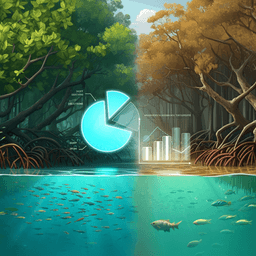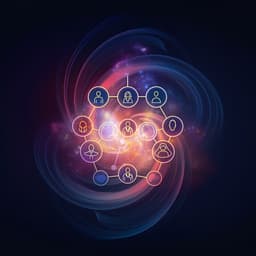
Veterinary Science
Global trends in antimicrobial use in aquaculture
D. Schar, E. Y. Klein, et al.
This study by Daniel Schar, Eili Y. Klein, Ramanan Laxminarayan, Marius Gilbert, and Thomas P. Van Boeckel examines global antimicrobial use in aquaculture, projecting a 33% increase by 2030. With significant implications for ecosystem health and food animal use, the findings emphasize the critical need for improved antimicrobial stewardship in this rapidly growing sector.
~3 min • Beginner • English
Introduction
Aquaculture is an increasingly important source of animal protein, especially in LMICs, with fish providing a significant share of global animal protein intake. Rapid growth and intensification in aquaculture, particularly in Asia and China, are occurring alongside increased antimicrobial use to manage disease and promote production, raising concerns about antimicrobial resistance (AMR) and environmental impacts. Compared to terrestrial systems, antimicrobial use in aquatic environments can lead to broader environmental exposure via water, potentially affecting microbiomes and ecosystem services. Aquaculture may act as a reservoir for resistance genes transferable across environmental, animal, and human compartments. Despite localized studies and qualitative reviews, global quantitative estimates of antimicrobial use in aquaculture are lacking. This study aims to estimate current (2017) and projected (2030) global antimicrobial consumption in aquaculture by species and geography, and to place these estimates in the context of human and terrestrial animal use to inform surveillance and stewardship policies.
Literature Review
The paper cites multiple geographically focused point prevalence surveys and qualitative reviews documenting antimicrobial use patterns, drivers, and regulatory contexts in aquaculture. Prior work highlights frequent use of quinolones, tetracyclines, amphenicols, and sulfonamides, with regulatory adherence influenced by export markets and maximum residue limits. Evidence suggests aquaculture environments may contribute to the selection and dissemination of resistance genes, including those on mobile genetic elements (e.g., mcr-1). However, comprehensive global, quantitative use data across diverse species and systems have been lacking, motivating the present synthesis and projections.
Methodology
- Study design: Estimate baseline (2017) and projected (to 2030) antimicrobial consumption in aquaculture by applying species-specific antimicrobial use coefficients (mg of active ingredient per kg biomass) to aquaculture production volumes by country/region and species.
- Systematic review: Searched peer-reviewed and grey literature (2000–2019) using terms for antimicrobials (antimicrobial/antibiotic/veterinary medicine), use (use/usage/consumption/amount/quantity), and aquaculture (aquaculture/aquatic/fish/shellfish/marine/freshwater). Identified 25 studies from 12 countries, yielding 146 biomass-adjusted point prevalence use rates.
- Species groups: Defined six categories: catfish, shrimp, salmon, tilapia, trout, and a pooled category representing other species or unspecified species from 11 surveys (12 species). Molluscs were excluded due to filter-feeding and unlikely mass antimicrobial administration.
- Production data and projections: Baseline production (2017) and projections (2018–2027) from OECD/FAO Agricultural Outlook for 33 countries, EU-28 as a block, six regions, and global totals; FAO FishStat provided 2017 country/region production for the five explicit species categories. The difference between total (excluding molluscs) and the five species sums was assigned to the pooled category. Compound annual growth rates from 2017–2027 were used to extend projections to 2030. Proportions excluding molluscs in 2017 were applied to future years to maintain consistency; species shares within each geography were scaled accordingly.
- Uncertainty estimation: For each species category, log10-transform of species-specific use rates was performed to normalize distributions. Means and 95% uncertainty intervals (mean ± t*SE) were computed on the log scale and back-transformed to derive mean use coefficients (mg kg−1) and 95% UIs. These coefficients were applied to projected production to obtain annual antimicrobial use and UIs by species and geography.
- Sensitivity analysis: Sequentially excluded each point prevalence survey and recalculated mean coefficients; surveys whose exclusion changed the overall mean by >2% were omitted (n=5). Similar checks were done at country level.
- Aggregate global consumption across sectors: Combined aquaculture estimates with terrestrial animal use (from Van Boeckel et al.) adjusted to revised biomass projections, and human use (from Klein et al.) using UN population and global average body mass. Aggregate uncertainty bounds summed lower and upper UIs for animal sectors with baseline/continued growth human use estimates.
- Additional analyses: ANOVA tested association between production system intensity (intensive, semi-intensive, mixed) and antimicrobial use; no significant association found (P=0.543). Trends by antimicrobial class were summarized from the systematic review.
Key Findings
- Global aquaculture antimicrobial consumption: 2017 estimated at 10,259 tons (95% UI 3,163–44,727); projected 2030 at 13,600 tons (95% UI 4,193–59,295), a 33% increase.
- Regional distribution: Asia-Pacific accounts for 93.8% of global consumption in 2017, remaining stable through 2030. Africa 2.3% (rising to 2.6% by 2030), Europe 1.8% (decreasing to 1.7%). Largest relative increases 2017–2030: Africa 50.9%, Latin America 50.6%.
- Country contributions (2017): China 57.9%, India 11.3%, Indonesia 8.6%, Vietnam 5.0%; projected 2030 shares: China 55.9%, India ~11.3%, Indonesia 10.1%, Vietnam 5.2%. Largest relative increases 2017–2030: Brazil 94%, Saudi Arabia 77%, Australia 61%, Russia 59%, Indonesia 55%.
- Species group consumption shares (2017): Pooled category 84.1%; catfish 8.3%; tilapia 3.4%; shrimp 2.7%; trout 0.8%; salmon 0.7%. Relative proportions remain stable through 2030.
- Mean use intensity by species (mg kg−1, 95% UI): Pooled 208 (70–622); catfish 157 (9–2751); trout 103 (5–1951); tilapia 59 (21–169); shrimp 46 (10–224); salmon 27 (17–41).
- Antimicrobial classes used (by frequency across surveys): quinolones 27%, tetracyclines 20%, amphenicols 18%, sulfonamides 14%. WHO-classified critically important and highly important antimicrobials accounted for 35% and 61% of use, respectively (96% combined). Highest mean class-specific coefficients: first-generation cephalosporins 85 mg kg−1; lincosamides 33 mg kg−1; tetracyclines 23 mg kg−1 (UI 11–45) (limited sample sizes for some classes precluded UIs).
- Production system intensity effect: No significant association between system intensity (intensive/semi-intensive/mixed) and use (ANOVA P=0.543).
- Cross-sector totals (2030): Global antimicrobial consumption projected at 236,757 tons (95% UI 145,525–421,426), with humans 48,608 tons (20.5%), terrestrial food animals 174,549 tons (73.7%), aquaculture 13,600 tons (5.7%).
- Use intensity comparisons (mg kg−1 biomass): 2017 aquaculture 164.8 mg kg−1 vs humans 92.2 mg kg−1 and terrestrial animals 140 mg kg−1. In 2030, aquaculture remains ~80% higher than humans (91.7 mg kg−1) and 18% higher than terrestrial animals.
- Geographic concentration: Trends dominated by Asia, especially China, which has produced more farmed fish by weight than all other countries combined since 1991.
Discussion
Global antimicrobial use in aquaculture is projected to rise substantially by 2030, with growth driven largely by production expansion in Asia, particularly China. Although aquaculture represents a smaller share of total global antimicrobial consumption than terrestrial animals, the estimated use intensity per biomass is higher, indicating potentially greater selection pressure per unit produced. The predominance of WHO critically and highly important antimicrobial classes in aquaculture use is concerning for public health, given limited therapeutic alternatives and the potential for resistance gene dissemination across aquatic, environmental, and human interfaces. Regulatory frameworks in export-oriented countries may constrain usage, but enforcement gaps and dual production systems (export vs domestic) can result in heterogeneous practices. Species-specific patterns suggest salmon often has lower antimicrobial use where vaccination and strong biosecurity are implemented, highlighting stewardship pathways—vaccines, improved husbandry, and management—to reduce reliance on antimicrobials. The findings emphasize the need for robust, standardized surveillance systems to track antimicrobial consumption in aquaculture, support targeted stewardship interventions, and integrate with resistance monitoring to elucidate use–resistance relationships across sectors.
Conclusion
This study provides the first global, species- and geography-resolved estimates and projections of antimicrobial use in aquaculture, showing a 33% increase from 2017 to 2030 and a high use intensity relative to humans and terrestrial food animals. Use is heavily concentrated in Asia, with China as the dominant consumer. Commonly used antimicrobial classes are critical for human medicine, underscoring stewardship urgency. The results support prioritizing the development of standardized antimicrobial use surveillance in aquaculture, strengthening regulation and enforcement, and promoting alternatives such as vaccination, improved biosecurity and husbandry, and emerging non-antibiotic interventions (e.g., phage therapy, probiotics, CRISPR-based strategies). Future research should address data gaps in major species (e.g., carp), improve temporal and farm-level consumption data, assess impacts of emerging pathogens and climate-driven shifts on use, and better characterize transmission pathways of resistance across the aquatic animal–environment–human continuum.
Limitations
- Data limitations: Estimates rely on a relatively small number of point prevalence surveys (n=25 studies; 146 use rates), with under-representation from China—the largest aquaculture producer—and key species such as carp. The pooled species category aggregates diverse species, which may not reflect true species-specific use rates.
- Methodological assumptions: Mean species-specific use coefficients were assumed constant from 2017 to 2030; projections reflect production growth only. Point prevalence surveys often capture single therapeutic/metaphylactic events rather than full production cycle totals, potentially underestimating use. Sensitivity analysis removed outlier surveys affecting means by >2%.
- System heterogeneity: The diversity of species (558 items farmed globally; 27 groups account for 90% of production) and production systems, including polyculture, creates high variability and wide uncertainty intervals. Dual systems for export vs domestic markets with differing practices are common in LMICs but could not be fully accounted for.
- External factors: Emerging and endemic aquatic pathogens, climate change impacts on fisheries, and shocks to terrestrial protein supply (e.g., African swine fever) may alter aquaculture output and antimicrobial use. Indirect antimicrobial inputs (e.g., livestock manure effluents into ponds) may not be captured, leading to underestimation.
- Surveillance and sales data: In contexts with off-label use and limited labelling for aquaculture indications, sales data may under-represent true consumption, complicating validation of estimates.
Related Publications
Explore these studies to deepen your understanding of the subject.







